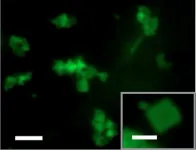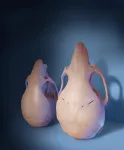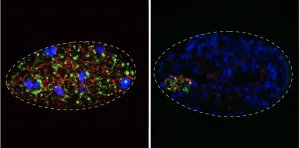IU research findings could reduce treatment-related complication for blood cancer patients
2021-01-07
(Press-News.org) INDIANAPOLIS-- Researchers at the Indiana University Melvin and Bren Simon Comprehensive Cancer Center published promising findings today in the New England Journal of Medicine on preventing a common complication to lifesaving blood stem cell transplantation in leukemia.
Sherif Farag, MD, PhD, found that using a drug approved for Type 2 diabetes reduces the risk of acute graft-versus-host disease (GVHD), one of the most serious complications of blood stem cell transplantation. GVHD occurs in more than 30 percent of patients and can lead to severe side effects and potentially fatal results. Farag is the Lawrence H. Einhorn Professor of Oncology and professor of medicine at IU School of Medicine, a member of the IU Simon Comprehensive Cancer Center and program and medical director of the hematological malignancies and bone marrow and blood stem cell transplantation at IU Health.
In the IU clinical study, blood stem cell transplant patients received the oral drug called sitagliptin. Acute GVHD occurred in only two of 36 patients within 100 days of their transplant. The 5 percent occurrence represents a drastic reduction of GVHD, which studies have found can affect 34 percent to 51 percent of patients in the first three months after transplant.
Graft-versus-host disease occurs when the donated blood stem cells (the graft) attack the transplant recipient's (the host) tissue.
"The rate looks very encouraging and it's achieved with a very simple and relatively inexpensive intervention of sitagliptin," Farag said. "This result is significant and offers a new approach and a new target for inhibition of graft-versus-host disease. We achieved a much lower rate than we could have hoped."
Sitagliptin targets an enzyme called dipeptidyl peptidase-4 (DPP-4), which is involved in a variety of processes in the body. It is used for Type 2 diabetes to improve insulin secretion and glucose control.
Hal Broxmeyer, PhD, a pioneer in the field of umbilical cord blood stem cell transplantation and distinguished professor at IU School of Medicine and a co-author with Farag, previously found that DPP-4 regulates blood cell production and explored if taking sitagliptin would improve engraftment for cord blood transplants. While there seemed to be some improvement in engraftment of cord blood transplants, one striking finding was the patients had a much lower rate of acute graft-versus-host disease than expected. Farag's lab took on that data and found targeting DPP-4 with sitagliptin inhibits the immune T cell activation that leads to GVHD.
Farag noted that repurposing sitagliptin offers a relatively inexpensive and accessible approach to preventing GVHD.
"These findings are very significant because there are a lot of other different drugs that are being tested, including ones that are very expensive or require administration intravenously for a prolonged time well beyond the time of recovery and transplant," Farag said.
Patients in the study were ages 18 to 60 and had one of the following blood cancer or diseases: acute myeloid leukemia (AML), acute lymphoblastic leukemia (ALL), chronic myeloid leukemia or myelodysplastic syndrome. The patients in the study received sitagliptin orally one day before their transplant and the day of their transplant, plus 14 days after their transplant.
Patients in the study did not face any unexpected or unusual toxicities or higher relapse rates than what's expected post-transplant.
"This is a drug that is used to treat diabetes, and we're using it at a much higher dose. We asked if we are going to cause people to have low blood sugar or hypoglycemia--and we didn't find that," Farag said. "As long as it's not combined with other drugs that lower the blood glucose in non-diabetic patients, it doesn't do that; we certainly confirm that in our findings."
Farag's findings now need to be confirmed with a larger, multi-center randomized study. He also hopes to explore combination therapies with sitagliptin and if it could prevent chronic graft-versus-host disease.
INFORMATION:
Additional authors from the cancer center are Mohammad Abu Zaid, MD, Jennifer E. Schwartz, MD, Rafat Abonour, MD, Michael J. Robertson, M.D., and Ann J. Blakley, B.S., as well as Teresa C. Thakrar, PharmD, of IU Health and Shuhong Zhang, PhD, of IU School of Medicine.
This study was supported by grants from the National Heart, Blood, and Lung Institute of the National Institutes of Health (R01 HL112669 and R35 HL139599) and the IU Simon Comprehensive Cancer Center.
[Attachments] See images for this press release:

ELSE PRESS RELEASES FROM THIS DATE:
2021-01-07
Chemists have developed a nanomaterial that they can trigger to shape shift -- from flat sheets to tubes and back to sheets again -- in a controllable fashion. The Journal of the American Chemical Society published a description of the nanomaterial, which was developed at Emory University and holds potential for a range of biomedical applications, from controlled-release drug delivery to tissue engineering.
The nanomaterial, which in sheet form is 10,000 times thinner than the width of a human hair, is made of synthetic collagen. Naturally occurring collagen is the most abundant protein in humans, making the new material intrinsically biocompatible.
"No one has previously made collagen ...
2021-01-07
Alexandria, Va., USA -- The COVID-19 pandemic has significantly impacted dental education and training. The study "COVID-19 and Dental and Dental Hygiene Students' Career Plans," published in the JDR Clinical & Translational Research (JDR CTR), examined the short-term impact of the COVID-19 pandemic on dental hygiene and dental students' career intentions.
An anonymous online survey was emailed to dental and dental hygiene students enrolled at Virginia Commonwealth University School of Dentistry, Richmond, USA. The survey consisted of 81 questions that covered a wide range of topics including demographics, anticipated educational debt, career plans post-graduation, ...
2021-01-07
CHAMPAIGN, Ill. -- In almost all successful advertising campaigns, an appeal to emotion sparks a call-to-action that motivates viewers to become consumers. But according to research from a University of Illinois Urbana-Champaign expert who studies consumer information-processing and memory, emotionally arousing advertisements may not always help improve consumers' immediate memory.
A new paper co-written by Hayden Noel, a clinical associate professor of business administration at the Gies College of Business at Illinois, finds that an ad's emotional arousal can have a negative effect on immediate ...
2021-01-07
Using stem cells to regenerate parts of the skull, scientists corrected skull shape and reversed learning and memory deficits in young mice with craniosynostosis, a condition estimated to affect 1 in every 2,500 infants born in the United States, according to the Centers for Disease Control and Prevention. The only current therapy is complex surgery within the first year of life, but skull defects often return afterward. The study, supported by the National Institute of Dental and Craniofacial Research (NIDCR), could pave the way for more effective and less invasive therapies for children with craniosynostosis. ...
2021-01-07
Humans feeding leftover lean meat to wolves during harsh winters may have had a role in the early domestication of dogs, towards the end of the last ice age (14,000 to 29,000 years ago), according to a study published in Scientific Reports.
Maria Lahtinen and colleagues used simple energy content calculations to estimate how much energy would have been left over by humans from the meat of species they may have hunted 14,000 to 29,000 years that were also typical wolf prey species, such as horses, moose and deer. The authors hypothesized that if wolves and humans had hunted the same animals during harsh winters, humans would have killed wolves to reduce competition rather than domesticate them. With the exception of Mustelids such as weasels, ...
2021-01-07
"Nature red in tooth and claw" - The battle to survive is fought down to the level of our genes. Toxin-antidote elements are gene pairs that spread in populations by killing non-carriers. Now, research by the Burga lab at IMBA and the Kruglyak lab at the University of California, Los Angeles shows that these elements are more common in nature than first thought and have evolved a wide range of mechanisms to force their inheritance and propagate in populations - a parasite within the genome.
Originally described in the model nematode Caenorhabditis elegans, toxin-antidote elements consist of two linked genes, a toxin and its antidote. While the toxin is loaded into eggs by mothers, only embryos that inherit the element express the antidote. Thus, the ...
2021-01-07
The National Human Genome Research Institute (NHGRI) within the National Institutes of Health (NIH) has released a new action agenda for a diverse genomics workforce. This ambitious set of goals, objectives, and implementation strategies details NHGRI's plans for enhancing the diversity of the genomics workforce by 2030.
"To reach its full potential, the field of genomics requires a workforce that better reflects the diversity of the U.S. population," NHGRI Director Eric Green, M.D., Ph.D., said. "Fostering an appropriately diverse genomics workforce of the future requires an immediate and substantial commitment ...
2021-01-07
Noncognitive skills and cognitive abilities are both important contributors to educational attainment -- the number of years of formal schooling that a person completes -- and lead to success across the life course, according to a new study from an international team led by researchers at Columbia University Mailman School of Public Health, the University of Texas at Austin, and Vrije Universiteit Amsterdam. The research provides evidence for the idea that inheriting genes that affect things other than cognitive ability are important for understanding differences in people's life outcomes. Until now there had been questions about what these noncognitive skills are and how much they really matter for life outcomes. The new findings are published ...
2021-01-07
What The Study Did: Under a range of assumptions of presymptomatic transmission and transmission from individuals with infection who never develop symptoms, the model presented here estimated that more than half of transmission comes from asymptomatic individuals.
Author: Jay C. Butler, M.D., of the U.S. Centers for Disease Control and Prevention in Atlanta, is the corresponding author.
To access the embargoed study: Visit our For The Media website at this link https://media.jamanetwork.com/
(doi:10.1001/jamanetworkopen.2020.35057)
Editor's Note: The article includes funding/support disclosures. Please see the article for additional information, including other authors, author contributions and affiliations, conflict of interest and ...
2021-01-07
What The Study Did: Population data from Denmark were used to examine whether age at exposure to negative experiences in childhood and adolescence (parents' unemployment, incarceration, mental disorders, death and divorce, and the child's foster care experiences) was associated with outcomes in early adulthood.
Author: Signe Hald Andersen, Ph.D., of the Rockwool Foundation Research Unit in Copenhagen, Denmark, is the corresponding author.
To access the embargoed study: Visit our For The Media website at this link https://media.jamanetwork.com/
(doi:10.1001/jamanetworkopen.2020.32769)
Editor's Note: The article includes funding/support disclosures. Please see the article for additional information, including other authors, author contributions and affiliations, ...
LAST 30 PRESS RELEASES:
[Press-News.org] IU research findings could reduce treatment-related complication for blood cancer patients




